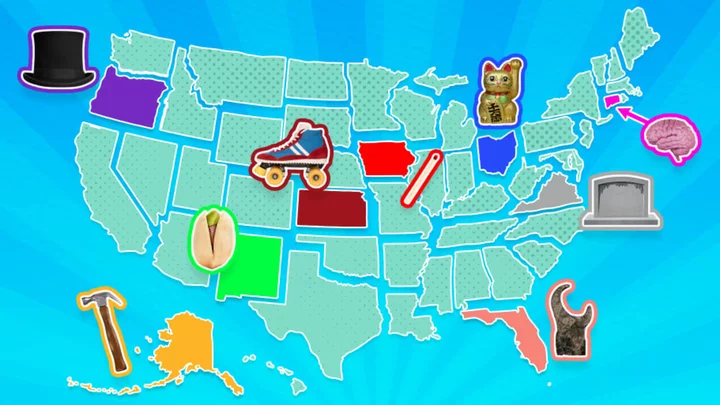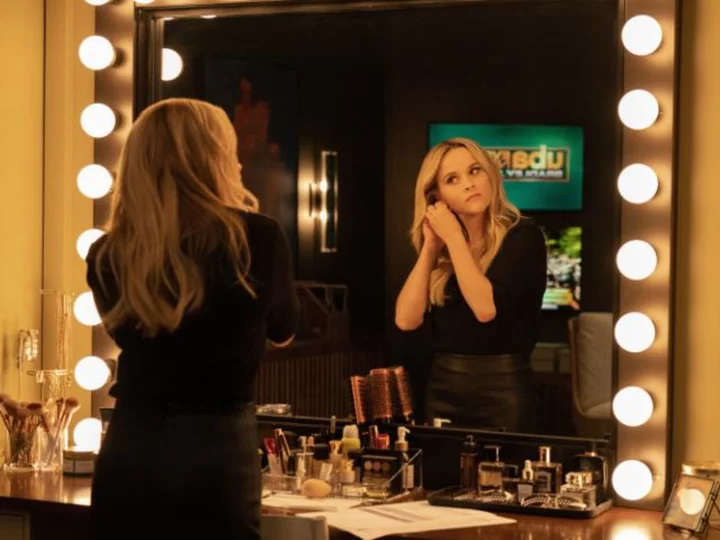From strange roadside attractions to wonderfully weird museums, the United States is full of delightful sights that don’t show up in all the guidebooks. Let’s take a roadtrip through the country, with stops at a self-flushing latrine, a collection of human brains, and much more, in this list, adapted from an episode of The List Show on YouTube.
1. Alabama // Fort Gaines
If you find yourself in Alabama, you can visit the U.S. Space & Rocket Center in Huntsville or catch the Crimson Tide at Tuscaloosa’s Bryant-Denny Stadium. But what do you do if you want to pantomime taking a number two with nine of your closest friends?
Alabama’s Fort Gaines features a “self-flushing latrine” that employs some very old technology: the tides of the Gulf of Mexico. The 10 adjacent privies—which did not afford soldiers much in the way of privacy—are located right along the coast; the tides were cleverly used to flush any waste away. You can visit today for a photo op, but not to ... well, you know.
2. Alaska // Hammer Museum
When all you have is a few thousand hammers, everything looks like a nail—or an opportunity to open one of Alaska’s most offbeat museums. Haines’s Hammer Museum “invites visitors to explore the rich history of the … world’s first tool,” in the words of its website. With everything from spring-loaded meat tenderizers to a hammer believed to have been used to help construct one of the pyramids at Giza, the museum has gained renown well beyond the 49th state; it actually made its way into a Jeopardy! clue back in 2016.
3. Arizona // London Bridge
The Hammer Museum is still hammering away, but London Bridge has fallen down. Or, more accurately, one iteration of that famous bridge was taken apart and shipped off to Lake Havasu, Arizona. Oil man Robert P. McCulloch purchased it back in the 1960s, figuring he could use it to draw in crowds to a planned community he was intent on building in the Copper State. Even today, you can visit London Bridge in the American southwest—or at least, a London Bridge, since the English landmark was eventually rebuilt.
4. Arkansas // The Gurdon Light
In the woods of Arkansas, you may be able to see a strange floating light. According to local folklore, it’s the supernatural lantern of a railroad worker who died prematurely, searching for his dearly departed head. In reality, it’s hard to be sure what causes the so-called Gurdon Light. It was actually featured in an episode of Unsolved Mysteries.
One theory is that the light is a result of piezoelectricity, a process in which things like crystals—such as the quartz known to exist under the ground in the area—convert mechanical energy into electrical energy. It may be that the pressure exerted on the quartz turns into the eerie light effects documented by observers.
5. California // The Museum of Jurassic Technology
California’s Museum of Jurassic Technology appears to be an oxymoron: How much technology was being implemented 150 million years ago?
That contradictory name may be fitting, though. The LA institution is both an ironic anti-museum and a celebration of museums, with exhibits on everything from “trailer park culture” to “the stink ant of the Cameroon of West Central Africa.” A New York Times reviewer commented that their visit left them with a “mixture of shock, marvel, delight, and confusion.”
6. Colorado // The Cold War Horse
Colorado is filled with natural beauty, but the Cold War Horse, also known as the Horse in the Hazmat Suit, is an unusual ode to a rather unnatural disaster.
The emergency-ready equine is located in Arvada, where the Rocky Flats nuclear weapons factory once sat. The sculpture was made by Jeff Gipe and commemorates the impact the nuclear facility had on the surrounding area and the people who worked there. That includes Gipe’s own father, who once worked at Rocky Flats.
7. Connecticut // The Cushing Center
The collection at Yale’s Cushing Center consists of hundreds of human brains collected in glass jars for medical posterity. It was started by Dr. Harvey Cushing, who is considered the father of modern neurosurgery.
And while you’re in New Haven, Connecticut, pay a visit to Yale’s Beinecke Rare Book and Manuscript Library. Though the reading room is limited to Yale students and other academics with an approved visit, they do have rotating exhibits accessible to the public. One of the collection’s prized possessions is the Voynich Manuscript.
8. Delaware // The World’s Largest Frying Pan
Some would say that Delaware can boast of an artifact just as valuable to international scholarship: a 10-foot-by-18-foot frying pan that, at one point, laid claim to the title of “world’s largest frying pan,” which can be found in Georgetown. This is no diva oversized frying pan: It was used at the Delmarva Chicken Festival for years, frying up an estimated 100-plus tons of fried poultry.
9. Florida // The Coral Castle
Miami’s Coral Castle appears, at first glance, like a cool, but not particularly noteworthy, sculpture garden. It becomes more remarkable when you learn that it was built single handedly by Edward Leedskalnin, employing methods that have still not been fully discovered. Ed had a slight frame, and yet was able to move and manipulate huge slabs of coral, perhaps drawing on his family’s experience as stonemasons in his birthplace—modern-day Latvia. Because he worked in secrecy away from prying eyes, there’s little documentation of his 28 years of impressive work.
10. Georgia // Rock City
On top of Georgia’s Lookout Mountain, you can find Rock City. Begun roughly a century ago by Garnet Carter and his wife Frieda, the location brings together beautiful nature, quirky gnomes, and “Mother Goose Village,” a miniature display of nursery rhyme characters. You’ll also see the remains of what may be the country’s first miniature golf course—depending how you define mini golf, that is. Though Lookout Mountain’s course was preceded by other versions that essentially shrunk the regular game of golf to a diminutive scale, Carter’s iteration—which he called “Tom Thumb golf”—incorporated some of the more whimsical features we associate with the game today, like a hollowed-out log that acted as a pipe to ferry balls towards the hole.
11. Hawaii // Iolani Palace
Hawaii’s Iolani Palace is not as quirky as a lot of the items on this list, but it is definitely unique in one respect: It’s the country’s only royal palace.
History buffs may recall that the United States has not, historically, been too crazy about monarchies. But our 50th state, Hawaii, was another story. It was an independent kingdom until the end of the 19th century. Queen Lili’uokalani lived at the palace until she was deposed by the euphemistically named Committee of Safety, a group composed mostly of businessmen who had the support of powerful figures in the U.S. After a failed attempt to reclaim the throne, the queen was actually imprisoned in a room at the palace for almost eight months.
12. Idaho // The Museum of Clean
Idaho’s Museum of Clean hopes “to expand the scope of clean into areas like clean homes, clean minds, clean language, clean community, and a clean world.” That mission, which, depending on the tone you read it in, could either come across as charming or sinister, is the driving ethos behind one of the odder museums you’ll likely come across.
If you want to visit the Museum of Clean and don’t mind a long drive, you could book a room in the state’s Dog Bark Park Inn, which is shaped like a couple of huge beagles. And if that’s not quite ridiculous enough for your needs, you may prefer the Potato Hotel, shaped like the state’s most famous crop.
13. Illinois // Rockmen Guardians
Illinois’s Rockmen Guardians look like the start of a delightful children’s movie. Sculptor Terese Agnew started making the rockmen back in 1987, and they still stand proud today.
14. Indiana // World’s Largest Ball of Paint
Michael Carmichael’s ball of paint in Alexandria, Indiana, began back in 1977, when he had his young son slather a layer of paint on a baseball. The ball now weighs 2.5 tons. Carmichael has incorporated a cool interactive element, inviting scheduled visitors to add their own coat of paint to the giant ball. “Some people call it weird,” Mike has said. “I like the idea that it’s something weird.”
15. Iowa // Matchstick Marvels
Where can you see the cathedral of Notre Dame, the U.S. Capitol, and the Millennium Falcon, all under one roof? Iowa’s Matchstick Marvels, home to model maker Pat Acton’s unique work. All the pieces are made out of humble wooden matchsticks, from a mini USS Constitution to an impressive rendition of Harry Potter’s Hogwarts School of Witchcraft and Wizardry.
16. Kansas // The World’s Largest Collection of World’s Smallest Versions of World’s Largest Things
The World’s Largest Collection of World’s Smallest Versions of World’s Largest Things is a bit of a mouthful, but if you follow the syntax, it makes perfect sense: It’s a broad collection featuring miniature versions of items that have gained renown for their oversized dimensions. Sure, a small version of “the world’s largest ball of yarn” might look a little bit like a regular ball of yarn, but there’s something delightfully off-kilter about the sensibility creator Erika Nelson brings to her one-of-a-kind Kansas attraction. Once they’re completed, Nelson often takes her small creations to the site of their oversized inspirations, thereby fulfilling the prophecy … or at least getting a cute photo for her troubles.
17. Kentucky // Vent Haven Museum
Fort Mitchell’s Vent Haven Museum is not, sadly, a museum dedicated to providing safe harbor to components of home and/or office ventilation systems. It is, rather, a place to display and celebrate the history of ventriloquism. It was founded by W.S. Berger and houses hundreds of dummies. It’s currently open by appointment only.
18. Louisiana // Abita Mystery House
Louisiana’s Abita Mystery House has an entire display dedicated to amateur paint-by-numbers artwork, interesting miniature scenes (including one portraying a jazz funeral), and even—in the words of their official website—“pure junk.”
19. Maine // The Umbrella Cover Museum
Maine’s Umbrella Cover Museum doesn’t feature junk, but it does honor a cultural artifact that doesn’t usually get a ton of attention: those little sheaths that you put an umbrella in when it’s not in use.
You could probably guess the museum would be unusual if you knew the name of its founder: Nancy 3. Hoffman. Sure enough, the museum’s website features a “Board of Troublemakers” in place of a Board of Directors, and the collection includes umbrella covers from dozens of different countries.
The Umbrella Cover Museum is the only attraction on this list (as far as we know) that was inspired, in part, by a bout of petty larceny. As Hoffman said, “I was in a dime store and I stole a cover off of an umbrella … just the cover. Then I knew I was hooked.”
20. Maryland // The Urology Museum
You do not want to get hooked at Maryland’s Urology Museum … at least not literally speaking, which will make sense if you get a peek at some of the frightening looking artifacts from early urology history. Though the collection of antiquated surgical tools might make you wince, the William P. Didusch Center for Urologic History—oddly named not after a urologist but, to quote the museum, “the foremost illustrator of American urology”—celebrates scientific progress that helps people out below the belt.
21. Massachusetts // The Museum of Bad Art
It would be tough to say what the best museum in Boston is: the Museum of Fine Arts is one of the biggest art collections in the word; the Isabella Stewart Gardner Museum features works by masters like Diego Velazquez and Albrecht Dürer, and even honors—in its own way—one of the most infamous art heists of all time. But where do you go if you’re sick of staggering beauty and incredible craftsmanship? The Museum of Bad Art, of course. Their mission? “[t]o bring the worst of art to the widest of audiences.” Of course, the idea of what constitutes “bad art” is subjective, but if you look at the MOBA’s collection—including themed exhibits like “PoorTraits” and “In the Nood”—you may be convinced.
22. Michigan // Marvin’s Marvelous Mechanical Museum
The World Almanac listed Marvin’s Marvelous Mechanical Museum in Farmington Hills, Michigan, as one of the United States’ 100 Most Unusual Museums. It features, among many, many other items, something called “The Disgusting Spectacle,” which is just an animatronic dude picking his nose. Admission to the museum is actually free, but that doesn’t mean you’re likely to walk away without spending a bit of money: There are rows of coin-operated pinball machines and uncategorizable oddities (like “The Guillotine,” which comes to life for a small fee). Even the ceilings are festooned with remote control airplanes on laundry conveying belts, contributing to a childish sensory overload that’s fun for any age.
23. Minnesota // The Spam Museum
Austin, Minnesota’s SPAM Museum celebrates the world’s most beloved packaged meat product (which may or may not be short for “Spiced Ham” or “Scientifically Processed Animal Matter”). One display features canstruments, musical instruments made partially out of cans of SPAM, as well as lunch boxes celebrating SPAM. You can learn about international uses of SPAM and find out how many cans of SPAM you’d need to trace the U.S.-Mexico border.
24. Mississippi // Bailey’s Scratching Post
If you’ve got an itchy back, hightail it to Lucedale, Mississippi. As long as you can make it to the city’s downtown business district before the sensation passes, you’ll be able to avail yourself of Bailey’s Scratching Post. The publicly available amenity started as a gimmick outside of an insurance company, and has been passed on from generation to generation. Some of the luminaries that have supposedly scratched their back on the post include Dizzy Dean, Kirk Douglas, and Ronald Reagan.
25. Missouri // 1859 Jail and Marshal’s Museum
Independence, Missouri, isn’t just the starting point for the Oregon Trail video game—it’s also home to the 1859 Jail Museum, which held prisoners from the frontier as well as military and civilian inmates during the Civil War. If you’re looking for a super spooky experience, you can even book a paranormal tour.
26. Montana // The Dumas Brothel
The Dumas Brothel, located in Butte, Montana, was open for almost a century, and it now has a second life as a one-of-a-kind museum. And that’s not the only second life purported to be happening at the former brothel. The site is said to be a hub for paranormal activity, and hosts ghost hunts for small groups. One spirit said to haunt the space is known as “The Judge”—another, according to psychic Kathleen Johns, is known as Bonita.
27. Nebraska // The National Museum of Roller Skating
Lincoln, Nebraska, is the home of the National Museum of Roller Skating. There are exhibits about trick skating and roller skating’s place in American culture, along with “approximately 1500 volumes of roller skating books and periodicals.”
28. Nevada // The Pinball Hall of Fame
If you roll up to Tim Arnold’s attraction in Las Vegas, Nevada, there isn’t much room for doubt about what you’ll find inside. The Pinball Hall of Fame features 25,000 square feet of games from decades of pinball history. Despite the name, it appears it’s more about celebrating and playing the pinball games, and not recognizing the greatest pinball players of all time. Sorry, Tommy. While you’re visiting, consider staying in Nevada’s World Famous Clown Motel.
29. New Hampshire // The Museum of Dumb Guy Stuff
The Museum of Dumb Guy Stuff may not be the most honest title on this list—it features a historically accurate recreation of Dover, New Hampshire, set in the year 1959, for instance—but, to be fair, “The Museum of Fairly Insignificant But Somewhat Delightful Things Two Guys Made in A Basement” doesn’t exactly roll off the tongue.
There’s a certain mad scientist vibe to the whole operation, if the mad scientist in question was interested in jamming customized figurines into a tiny space beneath a regular Portsmouth home. The museum, such as it is, almost never came to be. Rod Hildebrand shared a story about when his co-founder, Clay Emery, floated the idea by his wife. Apparently, she wasn’t immediately sold. “Well, it’ll keep me out of your hair,” Clay apparently said. “And she thought about it for a moment and said, ‘I support that.’”
30. New Jersey // The World’s Largest Lightbulb
Thomas Edison may not have invented the lightbulb, but his company did develop important improvements to the revolutionary invention that are honored today in Edison, New Jersey—in a big way. A “world’s largest light bulb” kind of way, in fact. The 13-foot-plus bulb dates back to 1938, and is sort of functional—today, it actually gets its illumination from LED lights, which is more environmentally friendly. For what it’s worth, since 2021 it’s actually been only the second-largest bulb in the world.
31. New Mexico // The World’s Largest Pistachio
One last “world’s largest” on this list—the world’s largest pistachio, in Alamogordo, New Mexico. Or, more accurately, the world’s largest pistachio model, which stands outside of PistachioLand.
32. New York // Treasures in the Trash
If you thoughtlessly threw out the world’s largest actual pistachio, there’s an off chance it would end up in New York’s Treasures in the Trash. That unique collection was started by retired sanitation worker Nelson Molina, mostly during his years working for the department from 1981 and 2015. It’s housed in an active sanitation garage in Manhattan, and features all sorts of things reclaimed from the New York City garbage, including autographed baseballs, countless old photos, and a who’s who of discarded cell phone styles.
33. North Carolina // The Road to Nowhere
When the Fontana Dam was built in North Carolina, a number of nearby towns were displaced; while they once sat along the Little Tennessee River, the rising waters forced residents to move. Old Highway 288 was submerged under Fontana Lake, a reservoir for the new dam. The federal government offered to build a new road connecting the towns of Bryson City and Deals Gap, partially so that displaced residents could still visit the burial sites of departed loved ones. That public works project was never completed, which led to our next attraction: It ends in a quarter-mile tunnel that leads … nowhere. One landowner, apparently displeased with the government's inaction, hung a sign nearby that read, “Welcome to the Road to Nowhere—a broken promise! 1943->?->”
34. North Dakota // Tent Pole Monument to Circus Dead
Visually, the Tent Pole Monument to Circus Dead is just a granite pole in a small cemetery, but the story behind it is awfully interesting … and, also, just awful. When Ringling Brothers came to Wahpeton in 1897, the show was intruded upon by a thunderstorm. Rather than canceling the performances, the traveling circus started to set up their act, including a large pole used to hold up the main tent. Tragically, lightning hit the pole, causing injuries that eventually killed three men. But even that terrible event wasn’t enough to cancel the day’s show.
Today, the monument—a stone replica of the original metal pole—stands in a cemetery just outside of town, a testament to the tragedy. Apparently, even in more recent years, when a circus comes nearby, workers from the troupe will visit the cemetery to pay their respects.
35. Ohio // The Lucky Cat Museum
Cincinnati’s Lucky Cat Museum—spelled mewseum on their website—features around 2000 maneki-neko, those adorable beckoning cats you’ve probably seen in an East Asian home or business. Though the iconic tchotchkes are proudly displayed in many Chinese establishments, they’re believed to be Japanese in origin, and to bring good luck to those who display them. The mewseum was founded by Micha Robertson. It started as her personal collection of a few dozen waving cats, and now features hundreds of permutations of sizes and designs.
36. Oklahoma // The First Girl Scout Cookie Sale Statue
Muskogee, Oklahoma, has a statue in honor of the first Girl Scout cookie sale. The first sale was organized by a local teacher to raise money for care packages that were sent to soldiers fighting in World War I.
37. Oregon // The National Hat Museum
Comedy writers refer to putting “a hat on a hat” when a premise is too overstuffed with ideas to be effective; in football, it’s a simple (if potentially injurious) explanation for effective run-blocking. But at Portland, Oregon’s National Hat Museum, putting a hat on a hat is just sound space management. When you have more than 2000 hats in one small location, after all, some stacking is inevitable. While the museum—which is temporarily closed—is normally a year-round celebration of millinery, you should really keep an eye out for their special events. Past highlights listed on the museum’s website include the requisite Kentucky Derby Day celebration along with less typical hat-centric affairs like the black-clad “Mausoleum Edwardian tea.”
38. Pennsylvania // The Magic Gardens
Philadelphia’s Magic Gardens, which are the brainchild of mosaic artist Isaiah Zagar, really are magical, creating a unique interplay of light and glass, recontextualizing found objects into a tiny world of beauty and discovery.
39. Rhode Island // Newport Tower
Rhode Island’s Newport Tower also has an interesting interplay with sunlight, though it may be best observed on winter solstice. On that date, the sunrise shines directly through two of the mysterious structure’s windows. There are a number of theories to explain the tower’s origin, some more fanciful than others. Could it have been created by Vikings? The Knights Templar? Chinese sailors in the 15th century? Shipwrecked explorers from Portugal? The most likely explanation isn’t quite so exciting—experts believe it dates to the 1600s, and is just the remnants of a mill.
40. South Carolina // Neverbust Chain
On Main Street in Columbia, South Carolina, there’s a gap between two buildings housing, respectively, a Brazilian steakhouse and a jeweler. About 15 feet above the ground, between the buildings, hangs the Neverbust Chain, a sculpture created by an American artist who goes by the name Blue Sky. The links of the chain are made of real steel, which couldn’t have been easy to install. So why did Blue Sky go to all the trouble? It’s tough to say. When asked, the artist was cagey, saying only that “One building looked like it was leaning a little bit.” The website RoadsideAmerica.com might have put it best, saying that the piece “signifies something, possibly.”
41. South Dakota // The International Vinegar Museum
If the other items on this list are too basic for you, check out South Dakota’s International Vinegar Museum. It was founded by Lawrence Diggs, “a.k.a. the Vinegar Man,” as the museum’s website proclaims. The museum is inside of an old gymnasium and features an international vinegar collection and even vinegar tasting opportunities.
42. Tennessee // The Salt and Pepper Shaker Museum
Tennessee’s Salt and Pepper Shaker Museum is perfect for those fall days when you’re admiring the foliage of the Great Smoky Mountains National Park, but wish you could also appreciate over 20,000 salt and pepper shaker sets. Jokes aside, this family-run attraction is absolutely charming, with sets depicting everything from sushi plates to foreign royalty to inexplicably fruit-headed artists.
43. Texas // Cadillac Ranch
Amarillo, Texas’s Cadillac Ranch is part Americana icon, part interactive project. It was installed decades ago in a collaboration between art collective The Ant Farm and multi-industry tycoon Stanley Marsh 3 and consists of 10 Cadillacs half-buried in the dirt. Visitors are able to add their own flourishes to the colorful designs.
44. Utah // Spiral Jetty
Located on the shore of Utah’s Great Salt Lake, Robert Smithson’s Spiral Jetty is considered an earthwork—“a work of art consisting of a portion of land modified by an artist,” as Merriam-Webster.com describes it. Smithson used thousands of tons of rocks to create the piece.
45. Vermont // The Museum of Everyday Life
Vermont’s Museum of Everyday Life centers simple, often human-made objects like the safety pin, toothbrush, and even dust, inviting us to reconsider the things all around us. “We celebrate mundanity,” its website proclaims, “and the mysterious delight embedded in the banal but beloved objects we touch everyday.”
46. Virginia // The Hollywood Cemetery
The Hollywood Cemetery does not, as you might imagine, belong roughly 40 states earlier on this list; it’s not in California, but in Richmond, Virginia. U.S. Commanders-in-Chief James Monroe and John Tyler are both buried there. So is Jefferson Davis, the first and only president of the Confederacy. And so is a vampire. Allegedly.
William Wortham Pool, whose tomb is found at Hollywood Cemetery, is widely discussed as a possible member of the undead in local legends. Sure, those stories may have been propagated by college students fueled by “chemical sensory enhancement and adrenalin,” as Richmond Magazine said, but it hasn’t stopped spooky-minded visitors from checking out the tomb for years.
47. Washington // Light Reign
Whether he’s creating one-of-a-kind light installations on the ceiling of the Guggenheim or working on his still-incomplete Roden Crater in Arizona’s Painted Desert, James Turrell creates work that plays with light, perspective, and space in ways that will change your perspective. And if you find yourself at the Henry Art Gallery on the campus of the University of Washington, don't miss the chance to see his piece Light Reign. The outside glows in a range of colors like the world’s coolest LED lamp. Once inside, you’ll notice that the roof has been cut open, inviting visitors to look up into the uninterrupted sky.
48. West Virginia // Archive of the Afterlife
West Virginia’s Archive of the Afterlife invites you to look toward (or is that beyond?) death. You can find haunted artifacts, items used for embalming, and opportunities to sign up for a ghost hunt.
49. Wisconsin // National Bobblehead Hall of Fame and Museum
Wisconsin’s National Bobblehead Hall of Fame and Museum in Milwaukee houses “the world's largest collection of bobbleheads from all genres and periods,” according to its website. There are 6500 bobbleheads in the collection, but “ONLY THE BEST BOBBLEHEADS WILL BE HALL OF FAMERS”—caps emphatically theirs.
50. Wyoming // Yellowstone’s Thermal Pools
Wyoming’s Yellowstone National Park is hardly quirky, but it has a unique attraction in several very pretty thermal pools that get their color in part from the heat-loving bacteria that live in them. The enzyme Taq polymerase, found in one type of those bacteria, also helped lead to a scientific breakthrough you may have experience with. PCR tests, like the kind often used to detect COVID-19, were developed in part by Nobel Prize winner Kary B. Mullis. That type of diagnostic often employs a technique called thermal cycling, a series of heating and cooling cycles that enables DNA replication. If you think about it, the varying temperatures of the thermal waters creates a natural version of this temperature cycling. Today, the Taq enzyme can be made in a lab, but we might not have developed PCR testing technology without discovering the naturally occurring bacteria.
51. Washington, D.C. // National Bonsai and Penjing Museum
Washington D.C.’s National Bonsai and Penjing Museum is free to visit and features a variety of beautiful trees in a tranquil setting. If you’re not familiar with the word Penjing, by the way, it’s basically the Chinese cousin of bonsai, with a subtle distinction. As practitioner Robert Steven described it, “penjing is more about artistic nuance in portraying natural phenomena; and bonsai is more disciplined in technical skill with the objective of suggesting the physical perfection of an old tree.”
Don’t forget to subscribe to Mental Floss on YouTube for more fun lists and interesting facts.
This article was originally published on www.mentalfloss.com as The Coolest Offbeat Attraction in All 50 States (and Washington, D.C.).









